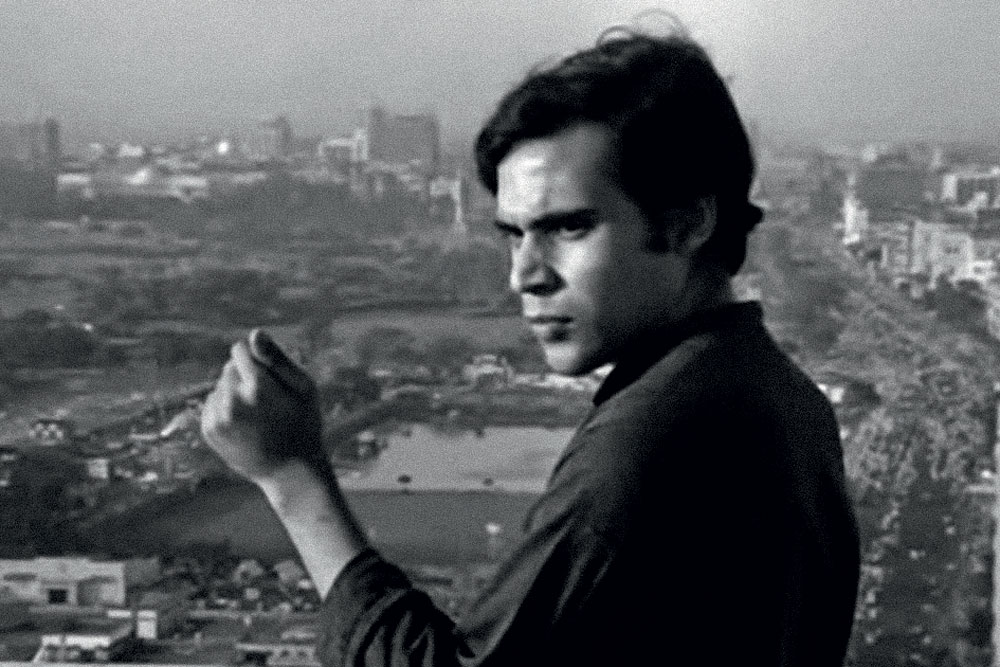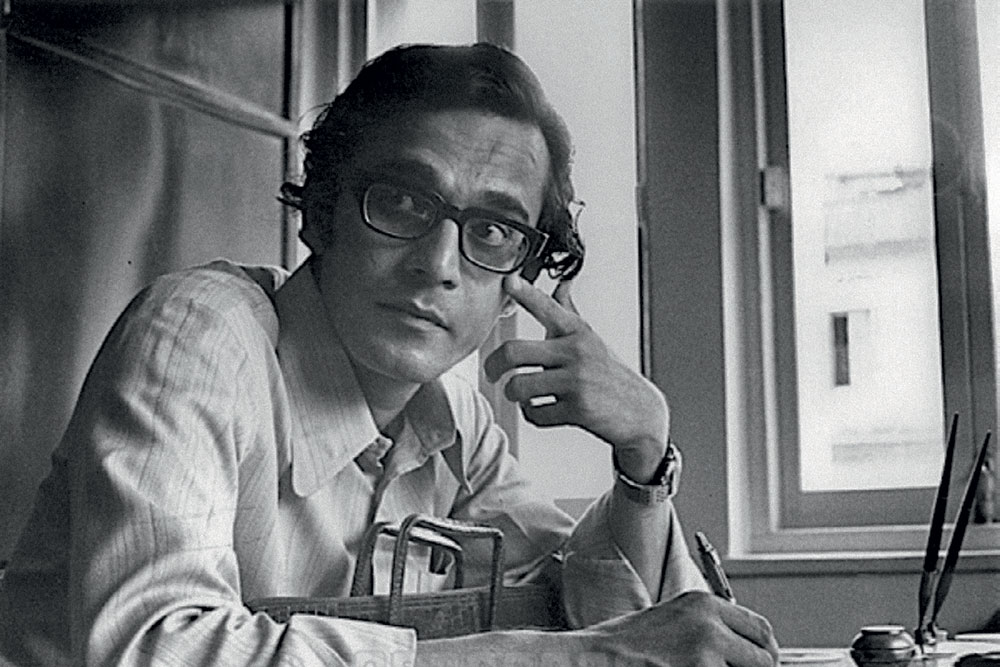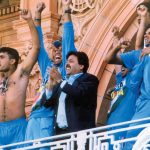A Humanist Behind the Camera
Ray chose his stories with the dexterity of a jeweller picking his diamonds. And he was far from naïve on politics
 Sumit Mitra
Sumit Mitra
 Sumit Mitra
Sumit Mitra
 |
30 Apr, 2021
|
30 Apr, 2021
/wp-content/uploads/2021/04/Humanist1.jpg)
(Illustration: Saurabh Singh)
At Tollygunj, a southern suburb of Kolkata housing Bengal’s film industry, he was universally known as ‘the tall man’ (dhyanga, in colloquial Bengali). At 6 feet 4 inches, for Satyajit Ray, it was no overstatement. Literally, and as a figure of speech. A full century after he was born (May 2nd, 1921), his global stature as a filmmaker still remains at the top perch. Nor is it much necessary yet to cross out the words of Penelope Houston, editor of the influential British film magazine Sight and Sound, in her 1963 book, Contemporary Cinema: ‘Satyajit Ray’s films will remain cinema’s India, until someone comes along to change it.’
Year after year, the pantheon of ‘great’ filmmakers has fattened, with regular accretion of ‘critics’ choice’ and ‘viewers’ choice’. Oscars, the US Academy of Motion Pictures awards, too, have been greatly democratised, with the industry’s top awards going to filmmakers alien to the Caucasian race. The medium itself is undergoing expansion and mutation; not in the epidemiological sense, though, but by temporarily quitting the dark auditorium to take refuge on the home TV screen, or being ‘streamed’ into the more portable tablet or smartphone. The walls of the film world’s hall of fame are indeed a slippery slope.
Yet, there are a handful of masters who have used the film medium to deep-probe their own cultures, using film technique to capture a geography while travelling back and forth in time. Like Akira Kurosawa, Orson Welles, Ingmar Bergman, Federico Fellini. David Lean or Billy Wilder. Satyajit Ray roosts comfortably with them. Kurosawa said feelingly about him: “Not to have seen the cinema of Ray means existing in the world without seeing the sun or the moon.” Martin Scorsese, the celebrated maker of Taxi Driver and The Wolf of Wall Street, was a teenager when Pather Panchali, the first of Ray’s Apu Trilogy, was released in New York, after its global premiere at the Museum of Modern Arts (MOMA). Scorsese was so ensnared with the experience that Ray became his lifelong icon and useful guide in later life. Decades after Ray’s demise, Scorsese played a key role in the restoration of Pather Panchali and Aparajito, the second film of the trilogy, which had been almost gutted in a nitrate fire in 1993. And, much to the joy of the Ray aficionados, the trilogy had a glorious commercial screening in New York in 2015. It brought back 60-year-old memories of the film getting premiered at MOMA following some passionate prodding by John Huston, the famed director-actor, who had seen some rushes of Pather Panchali during a short visit to Calcutta in 1954 and had been deeply moved.
In his native Bengal—on both sides of the international border—Ray is held in an esteem qualitatively different from that in which glam idols are apotheosised by the masses, a phenomenon that Ray himself analysed in his 1966 film, Nayak (‘The Hero’), featuring Uttam Kumar, the Bengali matinee idol. However, Ray is held in Bengal with the respect that only Rabindranath Tagore commanded. Like Tagore, who was a family friend, Ray too was a myriad-minded personality. His Apu Trilogy, the story of Apu, a Brahmin village lad coming of age, is showcased from his other achievements, like Kurosawa’s stunningly penetrating medieval fantasy Rashomon. But Ray’s oeuvre is fascinatingly wide.
Trained in the art school at Tagore’s Santiniketan, he worked, first as graphic artist and then as art director of the British advertisement agency DJ Keymer. Many discerning old Calcuttans of latter days were of the view that Keymer’s ads of the 1940s of the anti-malarial drug Paludrine, or those of the Tea Board, had the unmistakeable imprint of an aspiring filmmaker arranging images and words masterfully, to tell a story. In those days, many others were struck by the covers of the publications of Signet Press, a new publishing house owned by Ray’s boss at Keymer’s, DK Gupta. To design the covers of Signet’s books was Ray’s side job.

Gupta was an enterprising publisher who bagged Jawaharlal Nehru’s The Discovery of India as one of his first titles. But Signet worked wonders in the Bengali market. In Bengal, it was the age of the urban middle class which wallowed in the easy availability of books in Bengali that pleased the eye, the senses, and of course, the pocket. When the early editions of Banalata Sen, a book of poems of abiding popularity by Jibanananda Das, the most important modern Bengali poet after Tagore, reached the bookshops, Ray, its cover designer, also became a household name.
There was another book that came his way. It was a children’s edition of Pather Panchali, the novel by Bibhutibhushan Bandyopadhyay on which, one day, Ray would make his pathbreaking movie. Though he had a famous literary lineage—his grandfather Upendrakishore was a pioneer of halftone printing and an author of children’s books and his father Sukumar Ray a master of ‘nonsense’ poems à la Edward Lear—Ray Jr’s grounding in Bengali literature came later in life. Earlier on, he hadn’t even read much of Tagore, as he confessed; Bibhutibhushan was a far cry. It was during the shooting of Aparajito, the second trilogy film, in Varanasi that he tripped on the steps of a ‘ghat’ and suffered an injury that cost him two months of bed confinement. His associate and biographer Sunit Sengupta wrote that it gave him an opportunity to immerse in the rich seams of Bengali fiction, giving him an introduction to what would be the primary source of his filmography. Nevertheless, it was the abridged edition of Pather Panchali that opened a vista before him—of a young village girl and her younger brother running under a blue autumn sky, with a forest of the reedy white kash flower in the background. The image stayed in his head. In 1950, after a six-month study tour to London, during which he saw as many as 99 films, the return passage was the time when the image came back on paper, this time as a succession of pictures with the dialogue faithfully lifted from Bibhutibhushan’s novel. It came on screen five years later, following the resolution of the seemingly unending funding problems.
Ray’s political faith is at its grittiest when it comes to men grabbing authority over men with some excuse—be it hyper-nationalism or religion. And he understood how vulnerable India was to such ambush due to its proverbial inequality
THE PRESENT WRITER remembers watching Pather Panchali as a child in the company of his parents, and returning from the theatre in utter dismay to find both of them profusely in tears. It took a lot of growing up to understand that the film, far from being a tear-jerker, had startled the audience by being most un-cinematic in its presentation of life. The siblings, Durga and Apu, mother Sarbajaya, peripatetic father Harihar, old aunt Indir—they lived without a dramatic thread of story running through them. The two deaths in the film, of Indir and Durga, and the final migration of the remaining three to the distant city of Varanasi, leaving the ancestral home behind, were all absolutely natural, like flowers blooming and wilting. Or like movements in a sonata, as music-mad Satyajit would have put it. As a student, he saved tiffin money to buy used vinyl records of Mozart, Beethoven or Haydn from the footpaths of wartime Calcutta, trodden by GI soldiers on tour of duty.
From Pather Panchali in 1955 to Aparajito in 1956, and Apur Sansar (‘The World of Apu’) in 1959, the trilogy not only established as ‘real’ the rootless and inexplicably restless character of Apu. It created an acceptance of the film’s story flowing as naturally as life, or rather, like a river. It is an idea Ray imbibed from French filmmaker Jean Renoir who came to Calcutta to shoot The River and Ray got close to him, gaining from him a simple, organic view of art (which he had already developed from art teacher Nandalal Bose at Santiniketan’s art school) and a deeply humanist philosophy of life. It is to this quality of Ray’s films that Pauline Kael, the American film critic, referred when she wrote, ‘No artist has ever done more than Satyajit Ray to re-evaluate the commonplace.’ Without this skill, much of the Apu Trilogy would have seemed banal. Eventually, Ray turned it into his signature form.
In his 37-year-long filmmaking career, in which he made 36 films, feature and documentary, there is a noticeably large number of period stories set in 19th century Bengal, while quite a few, like Abhijan (‘The Expedition’, 1962), Jalsaghar (‘The Music Room’, 1958), or Ashani Sanket (‘Distant Thunder’, 1973) are tales from the near past. On the other hand, in films like Charulata (1964) and Ghare Baire (1984), both based on popular Tagore stories, and both love triangles, he chiselled the characters against a sharply etched historical background, eliminated all externalia, focusing on the deep moral torment of the protagonists. Especially in Charulata, it is only on a second viewing that one may second guess the time of the story; yes, it is around the second Anglo-Afghan war in 1879. Well, it is necessary to know that, as it takes the story into the middle of a great epistolary war then being fought in Bangadarshan, a magazine edited by novelist Bankim Chandra Chattopadhyay, about today’s chic dame versus the frumpy matron of the past. The little literary debate of a bygone era not only ricochets in the script, it symbolises the inner dilemma of Charulata, the central character exquisitely portrayed by Madhabi Mukherjee. Ray’s craftsmanship is reminiscent of Jane Austen’s famous self-description of her art as ‘a little bit of ivory on which I work with so fine a brush.’

Humanist and feminist, Ray chose his stories with the dexterity of a jeweller picking his diamonds. Jalsaghar, based on a Tarasankar Bandyopadhyay story, gave him an opportunity to redefine, a hundred years after the Permanent Settlement that had spawned the landlord class, their decadence in an extraordinary way, as a cash-burning passion for music. Its Chekhovian setting works at a deeper level as the landlord finds it difficult to communicate to the ‘new rich’ in a changing world, much like the characters in The Cherry Orchard. In Devi, a noir film set in the 19th century, superstition based on deification of humans combines with the hesitancy to challenge it. The cruelty of the theme stands in stark contrast to the gothic grandeur of the landlord’s mansion and the beauty of the river and its sandy banks. To Indians, among whom the ‘babaji’ cult has miraculously survived, the film may give a goosebump even now. But what’s surprising is that its pathos had a universal appeal that reached even Hollywood. Francis Ford Coppola, the maker of the Godfather series of films and a Ray buff, observed: “We know of Indian cinema through Ray’s works and, to me, his best is Devi, a cinematic milestone.”
Ray’s humanism transcends contemporary politics, though he attempted to plumb its depths in three of his Calcutta-based films—Pratidwandi (‘The Adversary’, 1970), Seemabaddha (‘Company Limited’, 1971) and Jana Aranya (‘The Middle Man’, 1975). Based on stories by two of Bengal’s most popular fiction writers, Sunil Gangopadhyay and Manishankar Mukhopadhyay, these films are peopled by credible contemporary characters, all trapped in the typical Indian paradox of individual aspiration thwarted by limited opportunity. He also gave an individual spin to historical events, like Ashani Sanket, on the Bengal Famine of 1943, or Shatranj ke Khilari, based on Premchand’s story about the 1856 annexation of Oudh by the East India Company. The famine, decried universally as due to Churchill’s arrogance, becomes, in Ray’s camera, an aubade to community fellow feeling. The Oudh annexation, while not ignoring the Company’s cupidity, transcends it to give a stark picture of Lucknow’s decadent Muslim nobility whose members, Mir and Mirza, would slither to a country garden to play a new game of chess even as Dalhousie’s Red Coats were marching into their city.
Ray attempted to plumb the depths of politics in three of his Calcutta films—Pratidwandi, Seemabaddha and Jana Aranya. These films are peopled by credible contemporary characters, all trapped in the typical Indian paradox of individual aspiration thwarted by limited opportunity
On politics, Ray was far from naïve. Belonging, like Tagore, to the Brahmo sect, which is opposed to polytheism and idol worship, his opposition to bigotry is visible not only in Devi but in Mahapurush (The Holy Man, 1965), a rib-tickling satire about an impostor who claims to have known Jesus Christ personally (“Men call it Crucifixion but to me it is Crucifact as I saw it happen”). But Ray’s political faith is at its grittiest when it comes to men grabbing authority over men with some excuse—be it hyper-nationalism or religion. And he understood how vulnerable India was to such ambush due to its proverbial inequality. In an interview with this writer in 1982, for the magazine India Today, Ray had said: “To me, the most important reality of post-Independence India is disparity. Disparity of income, disparity of opportunities, disparity of wealth.”
In Ghare Baire, the 1984 film based on a Tagore novel set in the background of the 1905 Bengal Partition, it is Bimala, the wife of Nikhilesh, the enlightened landlord (played by Victor Banerjee), who proves vulnerable. She gets ensnared by the charm of Sandip, the nationalist revolutionary (Soumitra Chatterjee), until the communal poison implanted in his nationalist theatrics hits the target. A riot breaks out and Nikhilesh dies in his attempt to douse the fire. Ray’s spite for religion and politics—the two-pronged evil—was in full play in one of his later films, Ganashatru, based on Ibsen’s play An Enemy of the People. In the play, trouble arises due to the spat between a resort town’s honest doctor and his politically ambitious brother, who is the municipal mayor and wants little fuss over the toxin samples in the spa waters tested by the doctor. In Ray’s film, the spa becomes a temple, the town’s main attraction, and the water pollution, caused by the damaged sewer pipes, threatens the distribution of ‘holy water’ to hordes of pilgrims, which is also the town’s economic lifeline. At a tense moment in the film, where the feuding brothers engage in a public debate that becomes one-sided due to the politician’s guiles, the latter asks his brother, “Are you a Hindu?” As it transpires, the question was a ploy to extract from him the statement that he had indeed not visited the temple. Such stupidity is answered with brickbats, bombs and eviction notices. That was months before LK Advani’s 1990 ‘rath yatra’; the Babri mosque in Ayodhya stood intact. The ‘tall man’ had indeed smelt the air! His ire at authoritarian, hierarchical government erupted in full fury in Hirak Rajar Deshe (‘The Kingdom of Diamond’), the 1980 musical fantasy. On the surface a sequel to his 1969 children’s fantasy Goopy Gyne Bagha Byne, it is in fact a brilliant spoof on Indira Gandhi’s 1975-1977 Emergency. The ‘kingdom’s’ only purpose of existence was to mine diamond, all for the king’s consumption. The kingdom had an evil genius scientist who operated a brainwashing machine. Even the worst critic of the cruel Diamond King would be brainwashed to call him ‘god’.
In the interview mentioned earlier, Ray was bitter about Emergency, but I had the feeling that the intense aversion he had to authoritarianism could have had a deeper fount than a shortlived spell of dictatorship in his own country. That remains a mystery.
Twenty-nine years after his death, Ray is still the chart-topper of Bengali children’s fiction, and his detective creations Feluda and Professor Shonku, the fictional scientist, are the twin heartthrob of generations of Bengali readers. To the falling number of those who remember his voice, it swung between bass and deep baritone. He spoke English with the effortless ease of a natural speaker, which, some say, he picked up from the BBC broadcasts during the war years. But BBC hardly teaches the spontaneous and very English turns of phrase, and the polished wit, that shone out in a conversation with him. That, too, remains a mystery. He also had a prodigious memory of trivia, designs and words. And musical notes that gushed forth even during the spells of illness before his death, with his fingers stroking the Roland keyboard.
It is doubtful if the combined grey matter of Feluda and Professor Shonku could unravel the enigma of the ‘Tall Man’ with a movie camera.

/wp-content/uploads/2025/07/Cover-Shubman-Gill-1.jpg)












More Columns
‘Fuel to Air India plane was cut off before crash’ Open
Shubhanshu Shukla Return Date Set For July 14 Open
Rhythm Streets Aditya Mani Jha